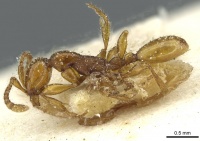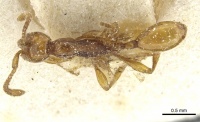Aenictus weissi
| Aenictus weissi | |
|---|---|

| |
| Scientific classification | |
| Kingdom: | Animalia |
| Phylum: | Arthropoda |
| Class: | Insecta |
| Order: | Hymenoptera |
| Family: | Formicidae |
| Subfamily: | Dorylinae |
| Genus: | Aenictus |
| Species group: | rotundatus |
| Species complex: | rotundatus |
| Species: | A. weissi |
| Binomial name | |
| Aenictus weissi Santschi, 1910 | |
Aenictus weissi is relatively well collected when compared to other Afrotropical Aenictus species. This is surely, in part, due to its large range. It occurs across central Africa from Guinea to Kenya. The number of collections also suggests it could be more common than most Aenictus species or, alternatively, spends more time above ground than their almost exclusively subterranean (= poorly sampled!) congeners. Specimen records show A. weissi has been collected in hand samples, pitfall traps, sifted leaf litter and rotten wood from various forest types. This includes both primary, mesic forests and disturbed areas, i.e. collections from secondary forest, mango and cocoa.
Identification
Gómez (2022) - A member of the rotundatus species complex in the Aenictus rotundatus species group. The lack of a developed subpetiolar process and the presence of a horizontal propodeal ridge separates this species from the rest in the rotundatus complex except for Aenictus nyuyi, but both species are separable by the shorter scapes (SIL<75 against SIL>80).
Keys including this Species
Distribution
Latitudinal Distribution Pattern
Latitudinal Range: 9° to -1.68333°.
| North Temperate |
North Subtropical |
Tropical | South Subtropical |
South Temperate |
- Source: AntMaps; Gomez, 2022
Distribution based on Regional Taxon Lists
Afrotropical Region: Cameroon, Congo (type locality), Gabon, Ghana, Guinea, Ivory Coast, Kenya, Nigeria, Rwanda, Uganda.
Distribution based on AntMaps
Distribution based on AntWeb specimens
Check data from AntWeb
Countries Occupied
| Number of countries occupied by this species based on AntWiki Regional Taxon Lists. In general, fewer countries occupied indicates a narrower range, while more countries indicates a more widespread species. |

|
Estimated Abundance
| Relative abundance based on number of AntMaps records per species (this species within the purple bar). Fewer records (to the left) indicates a less abundant/encountered species while more records (to the right) indicates more abundant/encountered species. |

|
Biology
Castes
Known from the worker and queen castes. Table of castes known for all Afrotropical Aenictus species.
Nomenclature
The following information is derived from Barry Bolton's Online Catalogue of the Ants of the World.
- weissi. Aenictus weissi Santschi, 1910c: 354, fig. 2 (w.) GABON.
- Type-material: holotype worker.
- [Notes (i): in the original description Santschi, 1910c: 354, states ‘a single example’; (ii) Gómez, 2022: 78, cites a second syntype from Gabon, collected in 1914 by F. Faure, which is not type-material.]
- Type-locality: Gabon (“Congo français”): Gomba (A. Weiss).
- Type-depository: NHMB.
- Santschi, 1920b: 9 (q.).
- Status as species: Forel, 1913j: 212; Santschi, 1920b: 9; Wheeler, W.M. 1922a: 755; Menozzi, 1942: 165; Eidmann, 1944: 429; Bolton, 1995b: 61; Gómez, 2022: 78 (redescription).
- Distribution: Cameroon, Democratic Republic of Congo, Equatorial Guinea (Bioko I.), Gabon, Ghana, Guinea, Ivory Coast, Kenya, Nigeria, Rwanda, Uganda.
Unless otherwise noted the text for the remainder of this section is reported from the publication that includes the original description.
Description
Worker
Gómez (2022) - HL: 0.65 [0.58-0.76]; HW: 0.53 [0.45-0.64]; SL: 0.45 [0.41-0.51]; WL: 0.99 [0.85-1.16]; PL: 0.24 [0.20-0.28]; PH: 0.18 [0.12-0.23]; PPL: 0.19 [0.16- 0.24]; PPH: 0.15 [0.11-0.18]; CS: 0.59 [0.52-0.70]; CI: 81 [75-87]; SIL: 69 [66-72]; SIW: 85 [77-93]; WL/HW: 186 [171-200]; PI: 134 [114-191]; PPI: 127 [111-163]; CSR: 134; (n=22).
Scapes moderately long, reaching three quarters of the head when laid back (SIL~70). Funicular segments 1 and 2 longer than wide, 3–7 subquadrate, apical twice and a half times longer than wide.
Head rectangular, longer than wide (CI ~ 80), convex laterally and widest at the middle, occipital line straight, ventrolateral margin not developing ventrally. Mandibles with a long, sharp apical tooth and 5–8 smaller triangular denticles. Frontal ridges present, not projecting anteriorly and not fused between sockets, intersection between anterior and vertical ridges elevated into a triangular lobe; parafrontal ridges weakly developed but present, in lateral view forming a small rounded triangle; in basal view parafrontal ridges about the same size than frontal ridges; both structures not extending from the antennal sockets.
Transverse mesopleural groove and mesometapleural suture present but not deeply impressed. Propodeal declivity slightly convex, encircled by a well-developed ridge, wider dorsally than laterally and projecting as a shelf in dorsal view.
Petiole with anterolateral and anterodorsal ridges well developed, dorsolateral absent. Petiolar dome with an anterior face sloping at 45 degrees approximately, anterodorsal angle obtuse, posterodorsal angle right, both rounded. Postpetiole with an anterior and posterior vertical faces and dorsal surface horizontal, but smaller than petiolar anterodorsal surface; anterodorsal angle obtuse, posterodorsal right, both domes without carinae or ridges of any kind. Subpetiolar process small, with an anterior face vertical or slightly anteriorly oriented, the rest shaped as a quarter of ellipse and without lamellae.
Head, scapes, pronotum, mesonotum, dorsopetiole and dorsopostpetiole, legs and gaster glassy smooth. Mesopleurae, metanotum and propodeum strongly reticulated. Lateropetiole and lateropostpetiole from alutaceus to reticulated. Some (4–5) horizontal rugulae present on metapleurae and anterior half of lateropropodeum. 1–2 horizontal rugulae may continue above the propodeal spiracle and on to the metapleural lobes. Overall colour light to dark brown, darker on head and mesosoma.
Whole body with sparse long decumbent to semierect white setae, including head, scapes and legs. Dorsum of propodeum bare except for its anterior and posterior borders. The length of the setae comparable to petiole height. No pubescence noted.
Type Material
- Syntype, GABON (as Congo fr.): Gomba (A. Weiss) (1w) [CASENT0911444] NHMB [Examined by Gomez, 2022]; Syntype, GABON, 1914 (F. Faure) (1w) MHNG [Examined by Gomez, 2022].
Gomez (2022): Type material is referred to Congo Francaise, Gomba. I’m assuming this location refers to Gomba city in Gabon. Although different catalogues cite the queen caste as described in SANTSCHI (1920), this reference only cites the species from Gabon, so the queen remains undescribed.
The specimen from Gr. Batanga (Cameroon) labelled as type has two identification labels: Aenictus weissi wasmanni Santschi and Aenictus rixator v. congolensis. Two more workers with the same data seem to belong to the same series and are labelled as Aenictus weissi wasmanni Santschi. This material is referred here to A. weissi, as A. weissi wasmanni seems to be unpublished.
References
- Gomez, K. 2022. A revision of the Afrotropical species of the Dorylinae ant genus Aenictus (Hymenoptera: Formicidae) based on the worker caste. Belgian Journal of Entomology 124: 1–86 (doi:10.5281/zenodo.5898821).
- Mbenoun Masse, P.S., Ebolo, G.L.M., Titti, G.E., Mony, R. 2021. Ant species richness, abundance and functional groups along an elevation gradient in Central Cameroon. Biodiversity Journal 12(1): 179-194 (doi:10.31396/biodiv.jour.2021.12.1.179.194).
- Santschi, F. 1910c [1909]. Formicides nouveaux ou peu connus du Congo français. Ann. Soc. Entomol. Fr. 78: 349-400.
- Santschi, F. 1920b. Formicides nouveaux du Gabon, du Congo, de la Rhodesia et du Natal. Ann. Soc. Entomol. Belg. 60: 6-17.
References based on Global Ant Biodiversity Informatics
- Borowiec M. L. 2016. Generic revision of the ant subfamily Dorylinae (Hymenoptera, Formicidae). ZooKeys 608: 1–280.
- Eidmann H. 1944. Die Ameisenfauna von Fernando Poo. 27. Beitrag zu den Ergebnissen der Westafrika-Expedition. Zool. Jahrb. Abt. Syst. Ökol. Geogr. Tiere 76: 413-490.
- Menozzi C. 1942. Formiche dell'isola Fernando Poo e del territorio del Rio Muni (Guinea Spagnola). 24. Beitrag zu den wissenschaftlichen Ergebnissen der Forschungsreise H. Eidmann nach Spanisch-Guinea 1939 bis 1940. Zoologischer Anzeiger 140: 164-182.
- Santschi F. 1910. Formicides nouveaux ou peu connus du Congo français. Annales de la Société Entomologique de France 78: 349-400.
- Santschi F. 1920. Formicides nouveaux du Gabon, du Congo, de la Rhodesia et du Natal. Annales de la Société Entomologique de Belgique 60: 6-17.
- Wheeler W. M. 1922. Ants of the American Museum Congo expedition. A contribution to the myrmecology of Africa. VIII. A synonymic list of the ants of the Ethiopian region. Bulletin of the American Museum of Natural History 45: 711-1004


